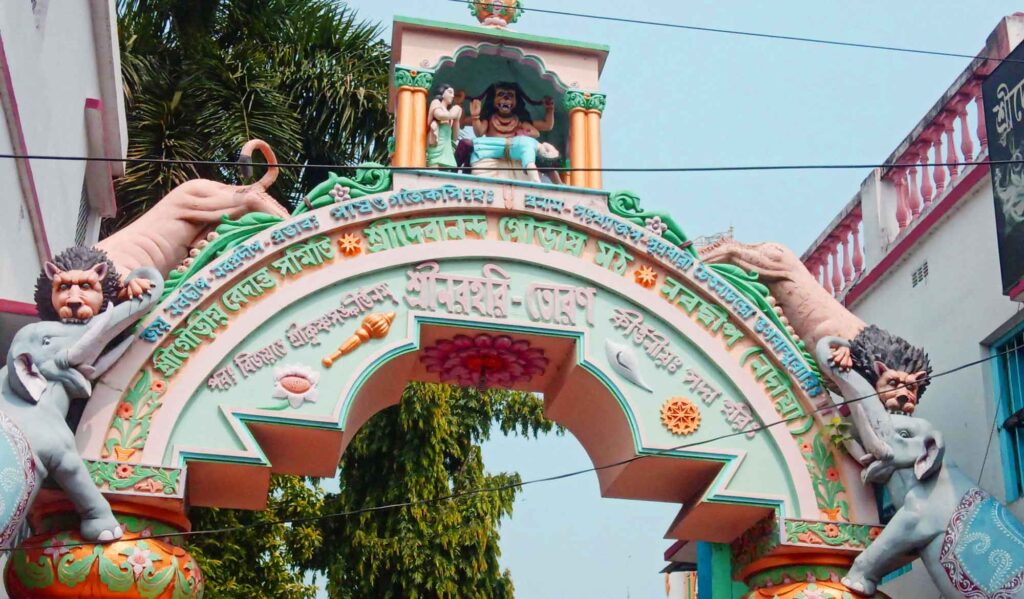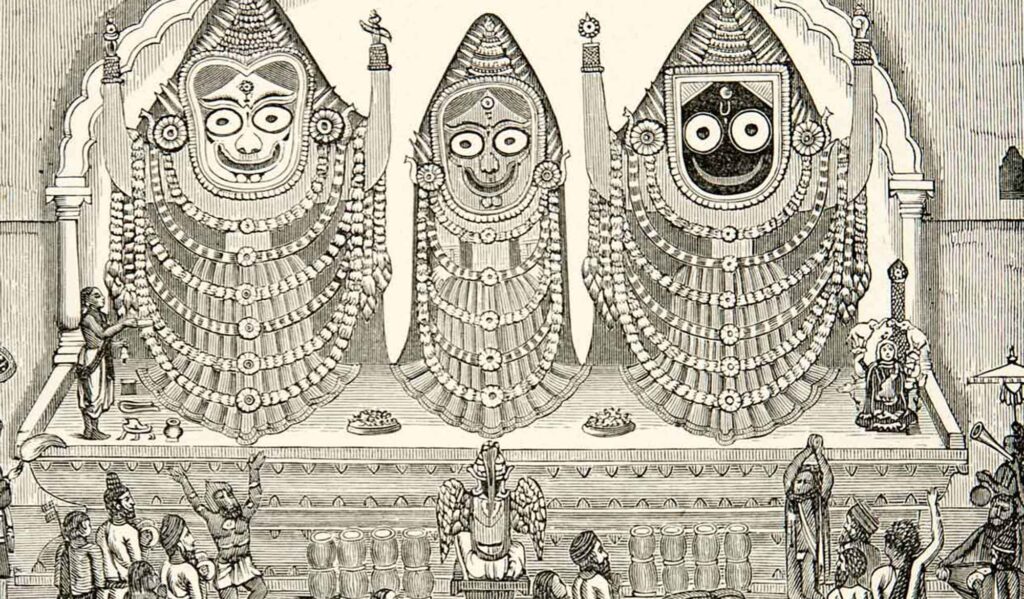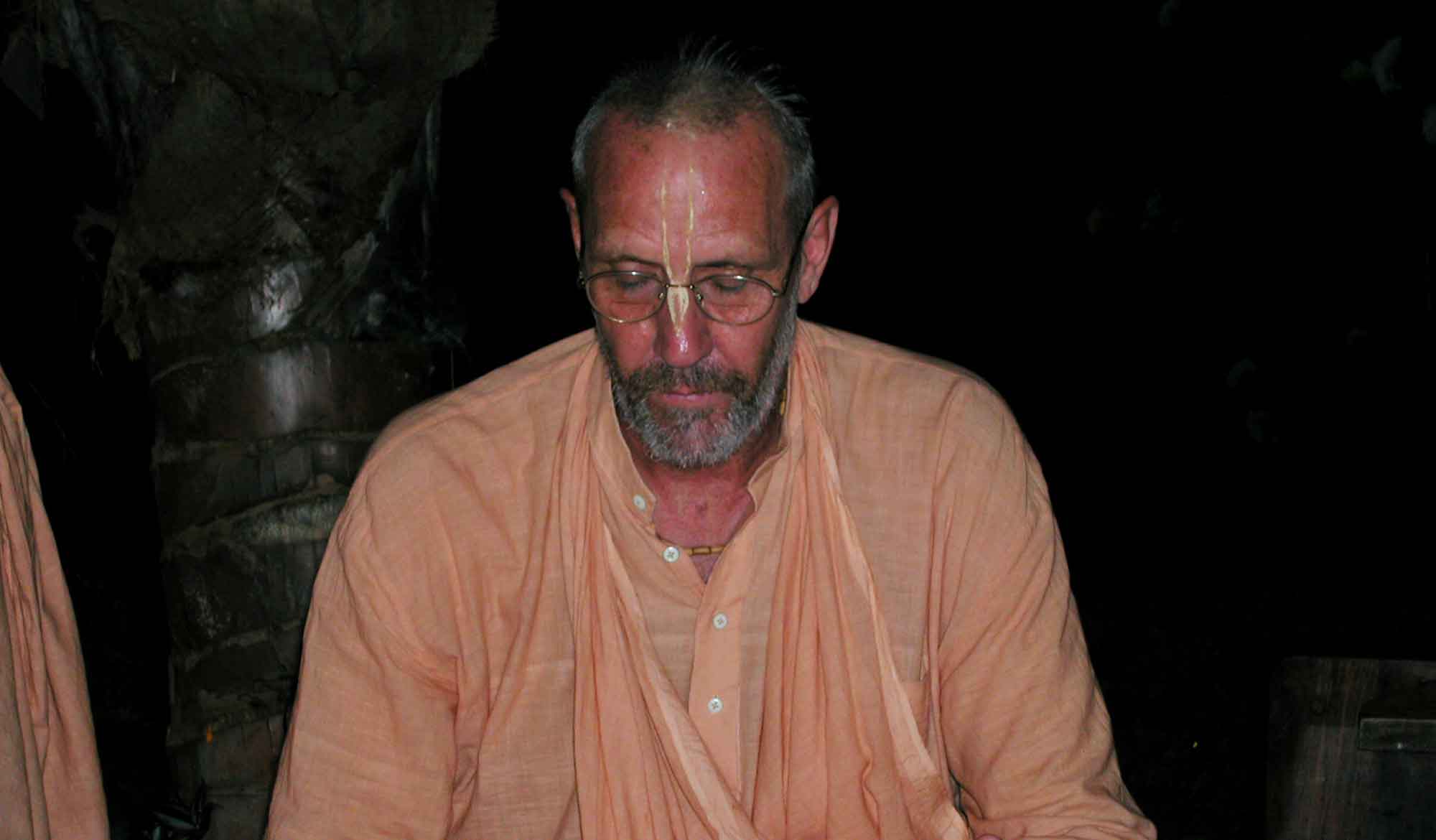by Swami B.G. Narasingha
The ‘Burning Cross – Part 1’ was the first in a series of articles written for VNN in 2003 by Śrīla Narasiṅgha Mahārāja under the pen-name of ‘Pradeep Sharma.’ For one year, after hearing many devotees begging the question about the connections between Vaiṣṇavism and Christianity, Śrīla Narasiṅgha Mahārāja wrote various articles on this subject. In this article, he shows how Christianity as we know it is derived from St. Paul, how the Jews were influenced by the Zororastrians (a renegade group from India), and about St. Thomas coming to India.
In one of my last visits to an ISKCON temple I was engaged in a conversation with a disciple of Srila Bhaktivedanta Swami Prabhupada about inter-faith dialogue, particularly about dialogue with Christians and incorporating Christian thought and spiritual practices into Kṛsna consciousness. I was respectful, as my position naturally demands when in the presence of a senior devotee, but at the same time I found that I was becoming quite annoyed with the conversation. My academic training as a historian kept ringing in my ear and I began to wonder what is it that the followers of the doctrine of Divine Love presented by Sri Chaitanya Mahaprabhu could possibly want to gain from an inter-faith dialogue with Christianity? Not much if anything, I thought.
Although Christianity has succeeded in pulling the blanket of deception over the eyes of the world with the fable of Jesus should not the Vaishnavas know better and see through such fraud and deception?
In the last few weeks I have come to understand that most Gaudiya Vaishnavas of the present day (Indian and Western) have very little knowledge of the history of Christianity, it origins, and its activities in the present.
Christianity as it were is an offshoot of Judaism that began in 58 AD circa under the ministry of Paul and later gained significant political power under the patronage of the Roman Emperor Constantine, 4th century.
In the first years after Jesus he was considered a man, a human, who like many others before him and during his time had come to fulfil the messianic prophecy of leading the Jewish people out of political bondage. Paul however insisted on deifying Jesus and preached that Jesus was the son of God or God Himself. Prior to Paul the concept of Jesus as more than a human being was not prevalent among the original Apostles. Paul also wanted to preach to gentiles (non-Jews) whereas Jesus himself had supposedly said that he came for the Jewish people only and this was being followed by the original Apostles of Jesus until Paul entered the scene. Paul eventually went against the laws of Moses and preached that one need not follow the laws of Moses. Thus he was to be reprimanded by the Apostles and in an act of rebellion he established his own cult that later came to be the standard of Christianity. Paul’s doctrine placed faith above works. This means that according to Paul there is no need to follow Jewish law, one only has to believe in Jesus. Since that time Christianity has been a doctrine of salvation through Jesus and not a search for truth, knowledge, or a method of attaining truth or knowledge of God other than Jesus.
It should also be mentioned that the early Christians did not call themselves “Christians”. They were in fact a minority within the Jewish community who went by the name Nazarenes and who thought that Jesus was the messiah of the Jews, or the Christ, but they did not call themselves “Christian” until the time of Paul.
You can ask any Jewish scholar and he will tell you that Jesus (if he existed at all) was a Jew who strictly followed the laws of Moses and that Christian doctrine is a Jewish heresy that originated with Paul in Asia Minor in 35 AD.
The Jews themselves have derived much of their doctrine from the Zoroastrians, as they lived under a Zoroastrian theocracy in Babylonia for nearly two centuries. The Zoroastrians, as it were, are a renegade cult of brahmanas led by Zoroaster who not accepting defeat before Rishi Vasistha fled India in ancient times and established their own monotheistic codes of religion, namely Zoroastrianism, the worship of Ahura Mazda and Mithras. The origins of Zoroastrianism are documented in the Rig Veda, verses 7.1.7, 7.9.6, 10.80.3 and the Bhavishya Purana, Pratisarga Khanda, Ch. 129-130. Rishi Vasistha is also mentioned in the Zoroastrian scripture “Zend Avesta”.
From the time of Rishi Vasistha to the Zoroastrians of Persia up to the Jews in the pre-Christian era there are various historical references that establish the authority of their cults and their founders, but when we enter the “Christian Era” there is no confirmable authority to establish that the historical Jesus ever existed. The fact that Jesus ever existed has never been verified by any historical accounts either church or secular. It is indeed very strange that no historical records of Jesus exist when we consider that Jerusalem at the time of Jesus was a haven for historians and scribes. Although the Bible (compiled centuries after Jesus and the only record of Jesus) speaks of thousands of people following Jesus such events are not mentioned in any of the old records of Jerusalem, either ethnic or Roman.
In the words of Pope Leo X of the 16th century, “How profitable that fable of Christ hath been to us and our company.” To this day there is still no proof of the historical Jesus. Strictly speaking Jesus still remains a cult fable. Thus the centuries old following of Jesus derives no more spiritual benefit than the modern following of Ayappa in Kerala. Neither of these personalities, Ayappa (mentioned nowhere in Vedic or Puranic literature) or Jesus (mentioned nowhere in Jewish or Roman literature), actually existed. Despite people having faith in these non-existent cult personalities no spiritual benefit is achieved because faith must be placed in reality and not in hearsay or myth.
For want of an actual Jesus and any sermons or miracles performed by him it turns out that all aspects of the Christian doctrine have been borrowed from either the Jews, the Zoroastrians, the Greeks, the Egyptians, and even the Vaishnavas. This is verifiable on each and every point of the Christian doctrine and legacy of Jesus from the numbers of disciples that Jesus had to each and every sermon that he gave or miracle he allegedly performed. Virtually nothing about Christianity is original or authentic. It is all a fabrication of bits and pieces of other cultural and spiritual traditions borrowed from here and there. What then have the devotees of Sri Chaitanya Mahaprabhu to learn from the so-called Christians other than the unwanted art of politics and deception?
In the 19th/20th centuries there was an international debate amongst scholars called “The Borrowing Theory.” “The “Borrowing Theory” suggested that the worship of Vasudeva Krishna was borrowed from Christianity. The brahmanas of India had little to contribute to this debate but thanks to the honest research of a small group of western archaeologists and historians the matter was finally settled in 1908 that the worship of Vasudeva Krishna predated the worship of Jesus at which point the topic of “The Borrowing Theory” was abandoned.
Many similarities between Vaishnavism and Christianity were discovered during the era of “The Borrowing Theory” with a view to establish Christianity as the roots of Vaishnavism, but when the attempt failed no one took up the opposing view to suggest that possibly it was Christianity who borrowed from Vaishnavism. When indeed it had.
No one in India presented the challenge to the world’s intellectual community because as Aurobindo once said, “The Indians have forgotten how to think.”
An interesting point to remember about Christianity is that although we hear that it is a doctrine of love and mercy taught by their saviour there is actually no point in Christian history or place in Christendom where an example of love and mercy is shown. On the contrary, from the birth of Christianity until the present day the Christians have left a trail of bloodshed and horror wherever they have gone in the world.
Of course history says that the early Christians were themselves persecuted by the Romans for their political activities (not for their religious beliefs), but when the tables had turned and the Christians rose to power they wasted no time in persecuting everyone and anyone who differed with Christian doctrine, even members of their own community.
When Christianity had purged the Roman Empire of what they called pagan practices (many of which had Vedic origins) Europe entered the “Dark Ages” and remained in such darkness until Sri Chaitanya Mahaprabhu appeared in India in 1486 and this eventually caused a Renaissance in Europe wherein came the rise of the Protestant Church. Unfortunately, the Protestants did no better than their forerunners.
The Christian trail of bloodshed and horror began from the time of Emperor Constantinus, the son of Emperor Constantine, when numerous “Christian” minorities were tortured and put to death for their beliefs in reincarnation and vegetarianism (doctrines borrowed from the East). The trail of bloodshed and horror has continued unabated throughout the Christian world until modern times. As late as 1560 AD circa the Inquisition was begun in India on the direct order of Saint Xavier and continued until 1812 AD. The Inquisition however had ended thirty-eight years earlier in Europe. During that time more than 2000 people were burned at the stake in India and all in the name of the cross. Sadly the Inquisition in India is a history that India’s secular education (heavily influenced by Christianity) refuses to acknowledge.
During the period of Portuguese occupation in India the myth of St. Thomas also gained popularity. According to legend St. Thomas the Apostle of Jesus landed in India in 52 AD at Cranganore, Malabar Coast and establish the first church later known as the Syrian Church. In 68 AD St. Thomas was allegedly martyred near modern day Madras/ Chennai and a large cathedral there now houses a basement crypt containing some relics of St. Thomas. This story of St. Thomas in India, however, has no verification or certification from the Vatican in Rome, but is nonetheless a powerful preaching platform when converting Hindus to Christianity, either Catholic or Protestant.
In the cathedral of St. Thomas at Chennai (Santhome Cathedral Basilica) there is also a painting that shows St. Thomas praying while he is being stabbed to death with a lance held by a Ramanuja Vaishnava brahmana wearing Vishnu tilaka. Once again we find that our brahmanas in India are sitting idle and not thinking or saying anything about this false propaganda that suggests that St. Thomas was killed by a Sri Vaishnava, when in fact the Sri Vaishnavas and their tilaka did not come into history until the 11th century AD.
These and other Christian propaganda that are based in lies and falsehood have gone unopposed throughout the world for twenty centuries. The result of which is that a major portion of the world population and even a large population here in India is now under the influence of the Christian heresy. When we see bona fide Vaishnavas also falling victim to this heresy it is indeed disappointing.
The Christian churches have a hundred-year plan to convert all of India and other parts of Asia to Christianity. To this end the Christians already control a large part of the educational institutions in India as well as a powerful control over the India media. At present there are 24 million Christians in India. One third of the population of Goa is Christian. One fourth of Kerala is Christian and Christianity is the majority in the states of Nagaland and Mizoram in the North East. Half the Christians in India belong to the Roman Catholic Church and the balance belong to various Protestant Churches.
What appears to be happening is that in the name of inter-faith dialogue the less informed devotees are unwittingly playing into the hands of the modern Christian crusade against Vaishnavism.
In any productive dialogue with a Christian it should be firmly demonstrated that any teaching of value found in Jesus is there within the teachings of Sri Chaitanya Mahaprabhu with the added advantage that the teachings of Mahaprabhu are much more extensive and direct.
Unfortunately, the brahmanas of India have for the most part become spiritual eunuchs and are useless for such purposes as propagating, defending, or even maintaining Vedic culture while their counterpart, the western Vaishnava communities, in the name of preaching widely are becoming more and more diluted by mixing everything and anything (such as Christianity and Buddhism, etc) with Krishna consciousness. If this trend continues then unfortunately the western Vaishnava communities may eventually become no more useful for the sankirtana Movement of Sri Chaitanya Mahaprabhu than our impotent brahmanas of India
More Articles by Swami B.G. Narasingha
The Sacred River Sindhu/Indus
‘The Sacred River Sindhu/Indus’ was posted by Swami B.G. Narasingha on his blog, narasingha.net, on October 2nd, 2011. In this short article, Narasingha Maharaja explains the significance of the River Sindhu and his pilgrimage to it. This article was later expanded into a bigger article called ‘Sindhu River – How India Got Her Name.’
Instructing the Guru
This article “Instructing the Guru” was written in April 2018 by Śrīla Narasingha Mahārāja who answers a question concerning a previous article wherein a Vaiṣṇavī writes a letter to her dīkṣā-guru and explains to him about the importance of śikṣā. In response, a question was raised by a devotee about the etiquette of a disciple instructing her guru.
The Atomic Ray – From Uniform Consciousness to Individual Conscious Units
In “The Atomic Ray - From Uniform Consciousness to Individual Conscious Units” written in 1996 Śrīla Narasiṅgha Mahārāja discusses the constitutional position of the jīva, according to Bhaktivinoda Ṭhākura and Śrī Caitanya-caritāmṛta.













